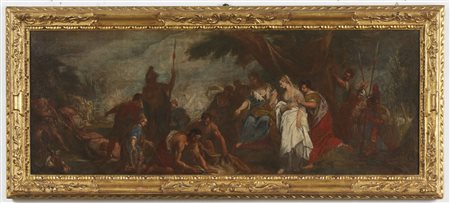 Capitolium Art - Via Carlo Cattaneo 55, 25121 Brescia
Capitolium Art - Via Carlo Cattaneo 55, 25121 Brescia
ASTA 184 - OLD MASTERS & XIX CENTURY ART 1A SESSIONE
mercoledì 10 giugno 2015 ore 16:00 (UTC +01:00)
MIGLIORI FRANCESCO (1684 - 1734) Didone che prepara la recinzione di...
MIGLIORI FRANCESCO (1684 - 1734) Didone che prepara la recinzione di Cartagine. Olio su tela . Cm 96,50 x 36,50. Il dipinto raffigura un soggetto raramente trattato nella pittura veneziana del settecento: Didone, seduta e circondata dalle sue dame e ancelle, che assiste alla riduzione in strisce della pelle di bue, che il re Iarba le aveva concesso come equivalente del terreno su cui fondare Cartagine. Il formato del presente dipinto, un rettangolo orizzontale fortemente allungato, si ritrova anche nelle tele conservate nelle chiese di San Marcuola e San Moisè (Adorazione del vitello d'oro), che hanno forti analogie stilistiche con l'opera qui proposta. Francesco Milgiori, veneziano, debuttò con un alunnato presso la bottega di Francesco Molinare, evolvette poi il proprio gusto verso il neoclassicismo veronesiano sul finire del seicento, maturando nel cromatismo del caposcuola Sebastiano Ricci. Al 1712 sono datate una serie di dipinti per la galleria dell’elettore di Sassonia Federico Augusto I che testimoniano l'interesse tributato al Migliori non solo nel contesto veneziano. Dalla fine del secondo decennio del settecento si fanno frequenti le commissioni da parte di chiese e istituzioni veneziane che testimoniano la maturità artistica e la sua affermazione nel contesto dei migliori artisti veneziani. il dipinto è corredato da scheda critica di Lucio Grossato. MIGLIORI FRANCESCO (1684 - 1734) Dido Preparing the Enclosure of Carthage. Oil on canvas "The painting depicts a subject rarely treated in the Venetian painting of the eighteenth century: Dido, sitting surrounded by her ladies and maids, watches as the cowhide granted by King Iarba as the equivalent of land on which to found Carthage is torn into strips. The format of this painting, a highly elongated horizontal rectangle, is also found in the paintings preserved in the churches of San Marcuola and San Moise (Adoration of the Golden Calf), which have strong stylistic similarities to the work presented here.Francesco Milgiori, a Venetian, debuted with an apprenticeship at the workshop of Francesco Molinare, then developed a taste in Veronese neoclassicism at the end of the seventeenth century, acquiring the chromaticism of the founder Sebastiano Ricci. A series of paintings for the gallery of the elector of Saxony Frederick Augustus I are dated 1712 and testify the interest paid to Migliori outside the Venetian context. Since the end of the second decade of the eighteenth century, he received frequent commissions from Venetian churches and institutions that testify to his artistic maturity and his establishment in the context of the best Venetian artists. The painting is accompanied by a profile by Lucio Grossato. " 96,50 x 36,50 cm. Cornice presente

